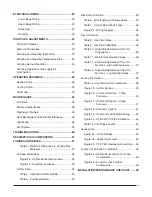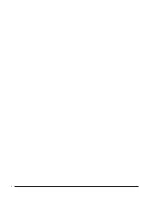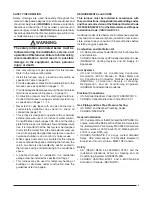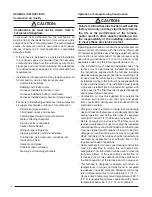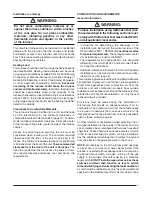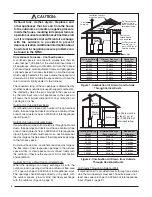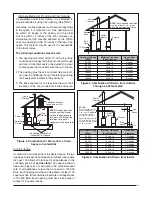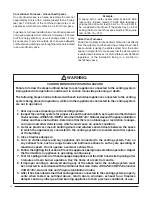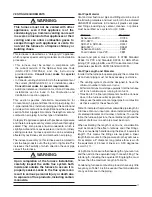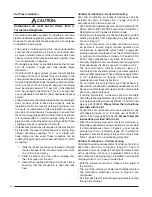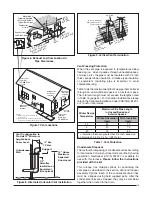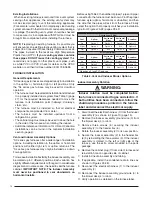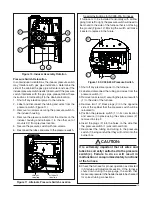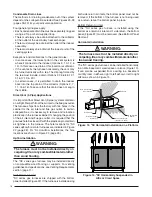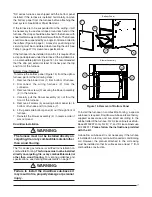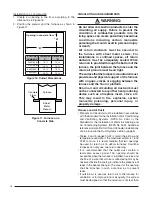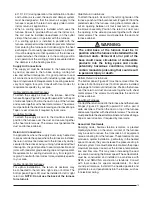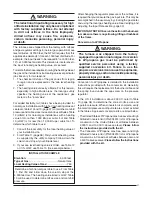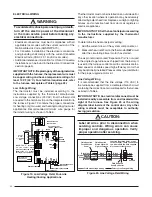
7
Installation in a Garage
WARNING:
Do not place combustible material on or
against the furnace cabinet or within 6 inches
of the vent pipe. Do not place combustible
materials, including gasoline or any other
fl ammable vapors and liquids, in the vicinity
of the furnace.
This Gas-fi red furnace may be installed in a residential
garage with the provision that the burners and igniter
are located no less than 18 inches (457mm) above the
fl oor. The furnace must be located or protected to prevent
physical damage by vehicles.
Heating Load
This furnace should be sized to provide the design heating
load requirement. Heating load estimates can be made
using approved methods available from Air Conditioning
Contractors of America (Manual J); American Society of
Heating, Refrigerating, and Air Conditioning Engineers;
or other approved engineering methods.
Excessive
oversizing of the furnace could cause the furnace
and/or vent to fail prematurely.
In addition, the ductwork
should be appropriately sized to the capacity of the
furnace to ensure its proper airfl ow rating. For installations
above 2,000 ft., the furnace should have a sea level input
rating large enough that it will meet the heating load after
deration for altitude.
Clearances to Combustible Materials
This furnace is Design Certifi ed in the U.S. and Canada
by CSA International for the minimum clearances to
combustible material listed in Table 3 (page 27). To obtain
model number and specifi c clearance information, refer
to the furnace rating plate, located inside of the furnace
cabinet.
Access for positioning and servicing the unit must be
considered when locating unit. The minimum required
clearance from the front of the unit for servicing is 24
inches. The minimum required clearance for positioning
is 30 inches from the front of the unit.
The recommended
clearance from the front of the unit is 36 inches.
The
need to provide clearance for access to panels or doors
may require clearance distances over and above the
requirements.
COMBUSTION AIR REQUIREMENTS
General Information
WARNING:
Furnace installation using methods other than
those described in the following sections must
comply with the National Fuel Gas Code (NFGC)
and all applicable local codes.
• Instructions for determining the adequacy of an
installation can be found in the current revision of the
NFGC (ANSI Z223.1 / NFPA54).
Consult local codes
for special requirements
. These requirements are for
US installations as found in the NFGC.
• The requirements in Canada (B149.1) are structured
differently. Consult with B149.1 and local code offi cials
for Canadian installations.
• Additional reference information for US and Canadian
installations can be found in the Combustion and Ven-
tilation Air section (page 5).
This condensing furnace is certifi ed for installation either as
a Direct Vent (2-pipe) or Conventional (1-pipe) appliance.
Direct Vent appliances draw combustion air from the
outdoors and vent combustion products back outside.
Installation with air taken from around the furnace is often
referred to as Conventional installation - i.e. only the vent
(exhaust) pipe is provided.
Provisions must be made during the installation of
this furnace that provide an adequate supply of air for
combustion. The combustion air from the outside needs
to be clear of chemicals that can cause corrosion. The
inlet pipe should not be placed near corrosive chemicals
such as those listed on page 6.
Another important consideration when selecting one or
two pipe installation is the quality of the Indoor air which
can sometimes be contaminated with various household
chemicals . These chemicals can cause severe corrosion
in the furnace combustion system.
A 2-pipe installation
has the additional advantage that it isolates the system
from the effects of negative pressure in the house.
NOTE
: Air openings on top of the furnace and openings
in closet doors or walls must never be restricted. If the
furnace is operated without adequate air for combustion,
the fl ame roll-out switch will open, turning off the gas
supply to the burners. This safety device is a manually
reset switch.
DO NOT install jumper wires across these
switches to defeat their function or reset a switch
without identifying and correcting the fault condition.
If
a switch must be replaced, use only the correct sized part
specifi ed in the Replacement Parts List provided online.



